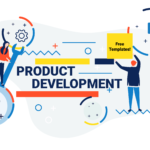Mastering The Path To Product-Market Fit
Last Updated on March 8, 2024 by Owen McGab Enaohwo
Every winning brand aims to gain more returns on investment (ROI) and turn customers into loyal advocates.
But no way will work if you don’t determine your product-market fit. In fact, you’re more likely to create a product no one wants and go bankrupt faster than it takes to make a cup of coffee.
In this article, we will explore what product-market fit is and how to determine yours.
Image Credit: mindtheproduct.com
What Is Product-Market Fit All About?
Product-market fit refers to building a market-relevant and profitable product in steady but continuous demand. It also describes the degree to which your product aligns with the current market needs and if it has a large customer base or audience of potential buyers willing to spend for value.
While that looks simple, most startups and age-long businesses hit the iron bar there.
Let’s use Kodak as a case study. They were the first developer of analog cameras and rolled the coaster with printed pictures. But Kodak failed to evolve with the market trend when cell phone innovations and online sharing came into play. Today, this giant of the 1950s now has less than $1 billion market value, a shadow of its former self.
A similar thing happened to Nokia, one of the first pioneers of a cellular network. When other horses rode the greener road to creating smartphones, Nokia took its time reveling in past glory until it could no longer put up a competition.
These two well-established tech pioneers show why prioritizing product-market fit is crucial for every brand at every level.
In one sentence: “If it’s not needed anymore and market-relevant, then it’s not fit.”
5 Simple Ways To Determine Product-Market Fit
Determining Product-Market Fit for your business is not rocket science. Follow these simple steps:
1. Conduct Multichannel Market Research
Before giving your product development team a green light, you should conduct in-depth research on your market.
- Is it a bad or good market?
- What is the trend?
- Is it seasonal or steady?
- Are there hidden challenges?
- As for past businesses that failed, what do they have in common?
These are just some of the things you need to check out. But beyond that, you also need to gauge your product’s market demand.
If there’s little demand, then you might not get enough profit for the value you provide. If the demand is high, getting a big pie shouldn’t be a problem.
At the same time, you should figure out your main competitors, their product’s strong points, and loopholes you can build on.
2. Create An Ideal Persona (Or Personas)
Knowing your market is not the end. You must also understand your target audience and create an ideal persona that represents them holistically.
However, creating an effective buyer persona requires determining your target audience’s needs.
- What are their pain points?
- What are they struggling with?
- What are their jobs to be done?
More often than not, people use the internet to search for solutions to their problems. By leveraging an SEO keyword research tool, you can quickly access and analyze what your target audience is looking for and if your product can cater to their needs. Pay close attention to the search volumes of the keywords they use.
Once that’s done, use your knowledge to create a buyer persona that contains your ideal customer’s demographics, pain points and needs, challenges, and geographic constraints.
3. Roll Out A Beta Product And Validate It Through Feedback
Collaborate with the developing team and give them access to your buyer’s persona. This will help them refine the final product to align with the market.
However, it is crucial to know that only customers can tell you if your product is fully market-fit.
And that is why you need to roll out a beta feature to collect your first stream of feedback and onboard some initial customers.
This feedback gives you a clearer understanding of your target customers’ needs. From there, your product team can implement necessary fixes and bring your product closer to a perfect product-market fit.
4. Deliver The Real Deal And Collect More Feedback
Remember we said the product-market fit methodology is not a one-time thing? It is something you apply before developing a product, during development, and after product release.
So once you’re done with the beta testing stage, roll out the real deal and grant users full access.
Over time, measure their interaction with your product or collect feedback through survey forms to know what needs fixing, replacing, or upgrading.
This cycle of feedback and implementation makes up the backbone of the product-market fit approach.
5. Keep Up With The Market Trend
While your product can be relevant and market-fit today, there’s no assurance it won’t fade out with time.
Remember the Kodak case study? A season welcomed analog cameras, and Kodak rode this wind. But after some time, mobile phones came in with file-sharing features and decided to take the stage.
That’s why it’s vital to follow the market trend and use it to predict possible changes.
Another case study is Google vs ChatGPT. ChatGPT took the internet by surprise in the last few years, and many speculated if Google would become obsolete.
But, so far, Google has proved critics wrong by introducing trend-matching AI integrations and continuously rolling out competitive updates that strongly contend with ChatGPT.
Visualizing Product-Market Fit As A Process, Not A One-time Thing
One of the common mistakes prominent companies and budding startups make is seeing product development and management as a one-time thing.
Building a market-fit product is a tangled, continuous journey with lots of milestones and challenges up the hill. This is especially true if your product caters to more than just one need or if you already have several thousands of capable competitors.
Also, note that you’re not just trying to build a product that is in demand and trendy; your target is to ensure that customers get value for their money. And if they don’t, it’s just a matter of time before they switch to another competitor with better value fulfillment.
Another pitfall for startups is that they fail to capture both short-term and long-term scenarios when doing market research to see if their product is a fit (and will always be a fit for the market).
Focusing only on short-term goals leaves you in the dark over time while competitors take advantage of your lack of insight to roll out jaw-dropping innovations that will kick you out of the market. Nokia’s case study is a reminder.
So you can see how the product-market fit methodology cuts across every timeline of your business and determines if you remain a relevant player or not in the long run.
Conclusion
By now, you should understand that building a great product is not everything. If your product does not meet customers’ needs, has sufficient market demand, and leverages word-of-mouth marketing, it’s not fit.
Before investing hundreds of thousands in developing a problem-solving product, ensure you’ve researched enough to know if your proposed product aligns with the target market.
Once you have a product-market fit, craft your long-term business strategies around it and start building.
Author Bio
Ayomide Olabode is a professional B2B analyst at Techiebode and the senior SaaS content writer for Digital Gratified. He is so enthusiastic about digging out new market strategies that work. And aside from writing during the day, you can find him trading the forex chart at night.
Get Your Free Systemization Checklist








Achieving product-market fit is a continuous process. While understanding your target audience is crucial from the get-go, companies must also be adaptable and data-driven. This means being able to collect and interpret user feedback and continuously improve the product based on market trends.
Thanks for joining the conversation.